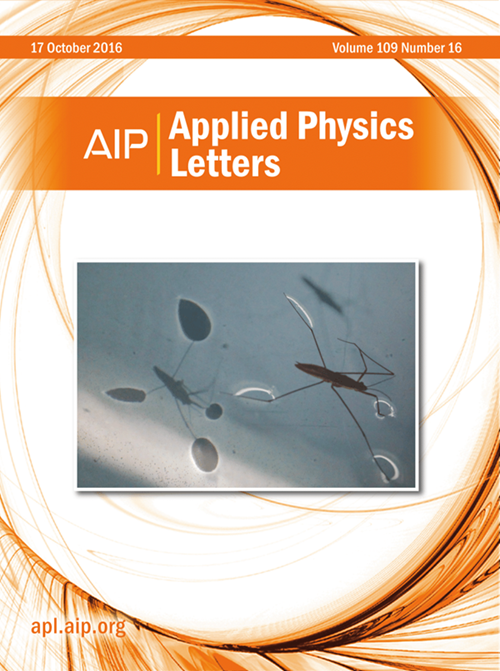Direct measurement of reduced exchange stiffness and its impact on magnetic vortex behavior in PyGd alloys
IF 3.5
2区 物理与天体物理
Q2 PHYSICS, APPLIED
引用次数: 0
Abstract
Thin films composed of sputtered transition metal/rare earth (TM/RE) ferrimagnets have emerged as promising building blocks for future spintronic devices, offering tunable magnetic properties critical for data storage, memory, and logic applications. However, understanding how the combination of TM and RE elements influences effective magnetic properties, such as exchange stiffness (Aex), remains challenging. Magnetic vortices provide a versatile tool for probing these properties in thin film systems. By combining magnetic imaging via soft x-ray microscopy and micromagnetic modeling, we quantify the effective exchange stiffness in PyGd ferrimagnetic disks with varying Gd concentrations. Our results indicate a reduction in Aex to below 3 pJ/m for a 20% Gd concentration when compared to reference Py, and values below 2 pJ/m for 30% Gd, reflecting weak Ni–Gd exchange coupling. These findings highlight the critical role of rare earth content in tuning the exchange stiffness. The reduced exchange stiffness facilitates a linear field response of the magnetization up to the edge of the disk, as well as significant deformations in the vortex core itself when compared to films with larger Aex. Our results are in line with, albeit lower than, recent measurements of the exchange stiffness in intermixed PyGd. This reduced exchange stiffness has implications for the development of spintronic devices based on ferrimagnetic skyrmions.交换刚度降低的直接测量及其对PyGd合金磁涡流行为的影响
由溅射过渡金属/稀土(TM/RE)铁氧体组成的薄膜已成为未来自旋电子器件的重要组成部分,具有对数据存储、记忆和逻辑应用至关重要的可调磁性能。然而,了解 TM 和 RE 元素的组合如何影响有效磁性能(如交换刚度 (Aex))仍然具有挑战性。磁涡旋为探测薄膜系统中的这些特性提供了一种多功能工具。通过结合软 X 射线显微镜的磁成像和微磁建模,我们量化了不同钆浓度的 PyGd 铁磁盘中的有效交换刚度。我们的研究结果表明,与参考 Py 相比,当 Gd 浓度为 20% 时,Aex 降低到 3 pJ/m 以下;当 Gd 浓度为 30% 时,Aex 降低到 2 pJ/m 以下,这反映出 Ni-Gd 交换耦合很弱。这些发现凸显了稀土含量在调整交换刚度中的关键作用。与具有较大 Aex 的薄膜相比,交换刚度的降低有利于磁化在磁盘边缘的线性场响应,以及涡核本身的显著变形。我们的研究结果与最近对混合 PyGd 中交换刚度的测量结果一致,但低于后者。这种交换刚度的降低对基于铁磁性天碲的自旋电子器件的开发具有重要意义。
本文章由计算机程序翻译,如有差异,请以英文原文为准。
求助全文
约1分钟内获得全文
求助全文
来源期刊

Applied Physics Letters
物理-物理:应用
CiteScore
6.40
自引率
10.00%
发文量
1821
审稿时长
1.6 months
期刊介绍:
Applied Physics Letters (APL) features concise, up-to-date reports on significant new findings in applied physics. Emphasizing rapid dissemination of key data and new physical insights, APL offers prompt publication of new experimental and theoretical papers reporting applications of physics phenomena to all branches of science, engineering, and modern technology.
In addition to regular articles, the journal also publishes invited Fast Track, Perspectives, and in-depth Editorials which report on cutting-edge areas in applied physics.
APL Perspectives are forward-looking invited letters which highlight recent developments or discoveries. Emphasis is placed on very recent developments, potentially disruptive technologies, open questions and possible solutions. They also include a mini-roadmap detailing where the community should direct efforts in order for the phenomena to be viable for application and the challenges associated with meeting that performance threshold. Perspectives are characterized by personal viewpoints and opinions of recognized experts in the field.
Fast Track articles are invited original research articles that report results that are particularly novel and important or provide a significant advancement in an emerging field. Because of the urgency and scientific importance of the work, the peer review process is accelerated. If, during the review process, it becomes apparent that the paper does not meet the Fast Track criterion, it is returned to a normal track.
 求助内容:
求助内容: 应助结果提醒方式:
应助结果提醒方式:


